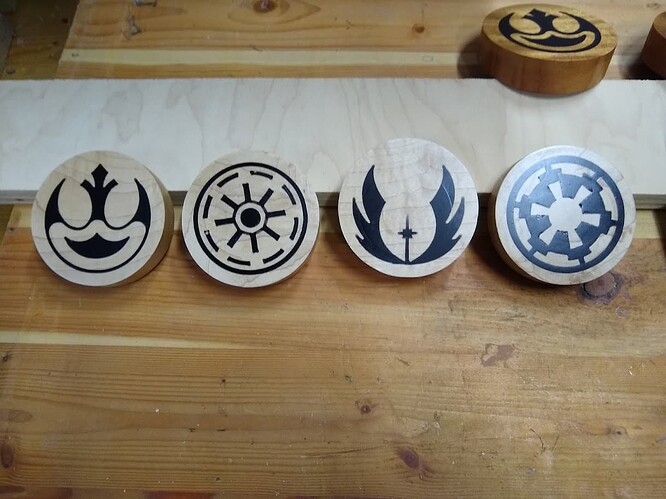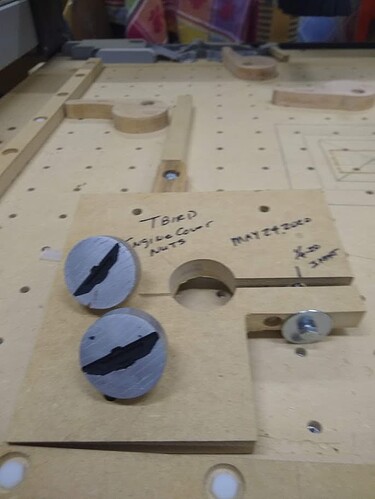Definitely sounds like the temp could be the culprit too. Maybe i should hold off on making anymore untill the weather warms up a little. I try to avoild appling finishes inside for health reasons.
Nitro Cellulose lacquer for sure leaves rings when cold/wet items are left on it to sweat. Its also susceptible to liquor/alcohol damage as can be seen on a few of my bar-fly guitars from the last 30 years. I don’t believe that is an issue with Pre-Cat lacquer though. As noted in the link above, Pre-Cat has an almost epoxy like component to it with a hardening agent of sorts.
Going a little off topic here, what do you guys use to colour your epoxy? Ive been playing around with dyes but i cant seem to get the darker opaque shades im looking for. Black has worked well, but colour seem to be very pale and adding more then a few drops seems to mess with the consistency of the epoxy too much. Ive seen others recommended acrylic paint, Think that may work better for darker shades?
I like the powder pigments from Eye Candy on Amazon.
For black and brown I use transtint liquid dye. For colors I use powder. If using powder you must mix very thoroughly. You must mix epoxy thoroughly anyway so I add the color after pouring the first part of the two part epoxy. then add the second half of epoxy and mix thoroughly. When you think you have mixed the epoxy enough mix it some more. The mixing is very important but if using like 5 minute epoxy the clock is ticking as soon as the second component hits the first so I have used 5 minute epoxy but avoid it because after about 3-4 minutes it starts to set so you have to be quick. So large pours or complicated pours use table top (adhere to maximum thickness) or slow set but slow set takes a week to harden (cure) and the color tends to drop to the bottom. So table top sets to jello consistently in about 15 minutes and usually dries overnight. Read and follow the directions for the type of epoxy you choose. Temperature has to be right or epoxy hardens too quickly or never sets. Epoxy needs to be poured at the recommended temperatures. I have successfully used the MAS Table Top epoxy and it works well. Always overfill because epoxy shrinks slightly when it cures.
This was maple with black transtint black dye and 5 minute epoxy.
These were before finishing and are the same maple ones from above with mahagoney.
Those look great, thanks for sharing. I’ve just been using epoxy i bought from my local craft store, not sure of the brand but it seems to work well enough. I don’t think its quick set as it doesn’t harden too quickly. I also bought some ink dyes, the black seems to work well but I haven’t had great luck with the colour. I think i might try the powder next, or maybe acrylic paint which seems to work well for some.
Oh, just one otherthing i was thinking about. What do you guys do with the waste generated from an epoxy pour? Unused epoxy, cups, sticks etc? Just toss it in the garbage? Or is there a more environmentally friendly way of dealing with the waste?
I made a rubber mould in the shape of a knob with a 5/16” bolt that fits in. The left over epoxy gets pored into that mould. Eventually the mold gets full and I take out the knob and start again. I use the knobs for any of my T slot jigs etc.
Some mixing cups you can let the epoxy dry and peel it out and resuse the measuring cups. The Popsicle sticks go in the trash. I try to only mix up the right amount. However it is better to have a little too much than a little too little. If you mix a lot too much set the excess outside.
When you mix epoxy you get a chemical reaction. That reaction leads to heat. That is why epoxy is rated in pour depth. The larger the mass of epoxy the more heat it generates. So if you mixed 5 gallons of epoxy together it would get much hotter than if you mixed up the same epoxy in a half a pint. Both get hot but the heat can lead to failure of your epoxy. So when mixing epoxy get it poured asap to avoid the mass heating that occurs. Now dont rush but rehearse your pour and have everything you need laid out and waiting. You do not want to have to start looking for something in the middle of mixing and pouring epoxy. That is just part of your organization you need to have to successfully do any craft project.
However in the end the waste epoxy just goes into the trash for me. Cured epoxy is not hazardous. Now in its raw and unmixed form it can be hazardous. In its initially mixed state it off gasses and some people can be sensitive to that off gassing. So wearing proper PPE and adhering to the OEM instructions is important.
I just waned to say thanks again for everyone helping me out here, I really appreciate all the awesome advice. I’ve just noticed one more thing I wanted to ask about. Just to try and get a better idea of the finish polyurethane gives, I sanded down those coasters I was working on and did 2 more coats of the spray poly with much longer drying time in a warmer environment and looks a lot better, very little orange peel effect. Just to test the strength of the finish, I scratched a small potion of the coaster with my finger nail and and it felt hard and didn’t leave any marks. However doing the same on the epoxy part felt softer and shows the scratches. Just curious if anyone had any thoughts as to why that might be?
Might be the dryng/curing time over the different materials. Meaning the wood probably absorbed of the poly and chemicals. The epoxy will not so it may take longer to dry. Think about spray paint on wood vs metals. which would dry faster?
That makes sense, thanks.
Are you guys super careful with the epoxy or do you flatten the coaster again on the CNC or sand after pouring?
I’ve been using the cnc to surface off the excess. For some reason i;ve been having a little trouble getting a perfectly flat surface after leveling but it’s so much easier then sanding. I think i just need to adjust my workholding.
You must overfill the pocket. The epoxy shrinks when it dries. So either you over fill and then surface that off or you fill just enough and have a low spot which still requires you to surface. Most table top type epoxy is thick enough to overfill without running all over the table. If you are worried about that then make a tape dam around the pocket before filling. You can surface with the Shapeoko or just use 60 grit sand paper and knock it down then progressive finer sand paper. The epoxy will look ugly after sanding even to 400. However when you put the finish on it will shine up. No need to polish it up to 120000 plus you would likely contaminate the surrounding wood.
For surfacing make your self a jig. I just cut the mdf on the Shapeoko and cut a slot on the table saw. I then used a bolt and/or clamp to squeeze the round coaster so I could surface it.
This topic was automatically closed 30 days after the last reply. New replies are no longer allowed.


